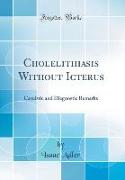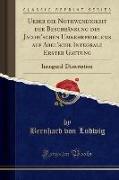Cholelithiasis Without Icterus
BücherAngebote / Angebote:
Excerpt from Cholelithiasis Without Icterus: Casuistic and Diagnostic RemarksIn the vast majority of cases coming under this head ing we have to deal with affections of the gall bladder and of the cystic duct. There are, however, observations recorded in which, after impaction of a gallstone in the common or in the hepatic duct, the disease has run its course, especially in the later stages, without jaundice, and this occurs when the ducts attain such a degree of dilatation that the bile can readily ¿ow by the impacted stones. Some years ago I had the opportunity of per forming an autopsy in a case - which was very interest ing for other reasons, and which has been published by Dr. Moschowitz - in which the gall bladder, the cystic duct, and the ductus choledochus up to the papilla of Vater, were filled with gallstones, as was also the hepatic duct, and in which the biliary passages were so dilated that a stasis of bile was impossible. As a matter of fact, no jaundice was present, at least during the period of observation. But I will not venture further into this field nor will I discuss diseases in more distant organs occasioned by gallstones, such as ileus due to biliary cal culi, obstruction of the pylorus, pylephlebitis, and throm bosis, all of which are usually not associated with jaun dice, for these digressions, cognate as they are to our discussion, would lead us too far.It is an old - established and unquestionable fact that calculi may lie in the gall bladder for many years, for even a lifetime, without calling forth clinical manifesta tions or decided anatomical changes. According to Schroder's statistics, gallstones are found in twelve per cent. Of all autopsies. If the calculi do produce symp toms, however, by far the most frequent is biliary colic.This arises from the forced entrance of a stone into a biliary passage, in our cases into the cystic duct. The ac tive causes in driving calculi from the gall bladder into the cystic duct have not yet been clearly ascertained, but it appears to be definitely proved that processes going on in the stomach and intestines play an impor tant role. It has been ascertained that increased peristal tic movements of the stomach and intestines, that trac tion due to a distention of the gut, to unusually severe exercise, etc., evoke spasmodic contractions of the mus cles of the gall bladder, which tend to drive the calculus toward the duct. Riedel doubts, and as I think justly, whether the rather slight muscles of the gall bladder are capable of exercising such colossal pressure, especially when the cystic duct is patent. He assumes that in every case an initial in¿ammatory process causes, on the one hand, intumescence and stenosis of the cystic duct with consequent stasis in the gall bladder, and on the other hand increases the pressure within the gall bladder by in ¿ammatory transudation to such an extent that the cal culus is driven into the cystic duct with great force. He leaves us entirely in the dark, however, how to account for such an in¿ammatory condition or how to explain such an aseptic process, and it must certainly be asep tic, for in a whole series of cases the bile was found to be sterile even during an attack.About the PublisherForgotten Books publishes hundreds of thousands of rare and classic books. Find more at www.forgottenbooks.com
Folgt in ca. 10 Arbeitstagen

